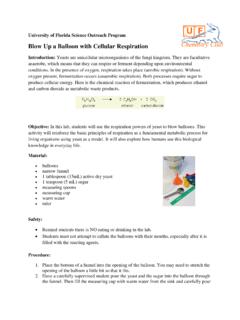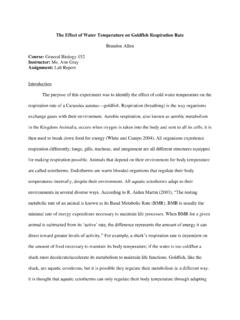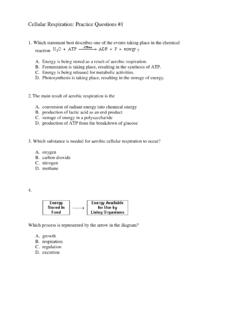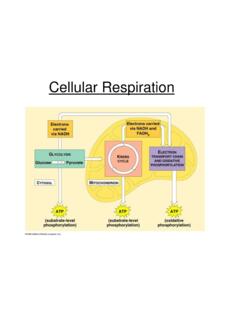Transcription of AP BIOLOGY – CHAPTER 7 Cellular Respiration Outline
1 AP BIOLOGY CHAPTER 7 Cellular Respiration Outline I. How cells get energy. A. Cellular Respiration 1. Cellular Respiration includes the various metabolic pathways that break down carbohydrates and other metabolites and build up ATP. 2. Cellular Respiration requires oxygen and gives off CO2. 3. Aerobic Respiration usually breaks down glucose into CO2 and H2O. 4. Overall equation for complete breakdown of glucose requires oxygen (is aerobic): C6H12O6 + 6O2 6 CO2 + 6 H2O + energy 5. Glucose is high-energy molecule; CO2 and H2O are low-energy molecules; process is exergonic and releases energy.
2 6. Electrons are removed from substrates and received by oxygen, combines with H+ to become water. 7. Glucose is oxidized and O2 is reduced. 8. Buildup of ATP is an endergonic reaction that requires energy. 9. Pathways of aerobic Respiration allow energy in glucose to be released slowly; ATP is produced gradually. 10. Rapid breakdown of glucose would lose most energy as non-usable heat. 11. Breakdown of glucose yields synthesis of 36 or 38 ATP; this preserves 39% of energy available in glucose. B. NAD+ and FAD. 1. Each metabolic reaction in Cellular Respiration is catalyzed by its own enzyme.
3 2. As a metabolite is oxidized, NAD+ accepts two electrons and a hydrogen ion (H+);. results in NADH + H+. 3. Electrons received by NAD+ and FAD are high-energy electrons and are usually carried to the electron transport system. 4. NAD+ is a coenzyme of oxidation-reduction since it both accepts and gives up electrons. 5. Only a small amount of NAD+ is needed in cells; each NAD+ molecule is used over and over. 6. FAD coenzyme of oxidation-reduction can replace NAD+; FAD accepts two electrons, becomes FADH2. This is only a general Outline .
4 There is much that has been discussed and presented in lecture that is not included in this Outline . All material discussed in lecture is test-material whether or not it is included in this Outline . C. Phases of Complete Glucose Breakdown 1. Aerobic Respiration includes metabolic pathways and one individual reaction: a. Glycolysis is the breakdown of glucose to two molecules of pyruvate. 1) Enough energy is released for immediate buildup of two ATP. 2) Glycolysis takes place outside the mitochondria and does not utilize oxygen.
5 B. The transition reaction: pyruvate is oxidized to an acetyl group and CO2 is removed. c. The Krebs cycle: 1) This series of reactions gives off CO2 and produces ATP. 2) Produces two immediate ATP molecules per glucose molecule. d. The electron transport system: 1) Series of carriers accepts electrons from glucose; electrons are passed from carrier to carrier until received by oxygen. 2) Electrons pass from higher to lower energy states, energy is released and stored for ATP production. 3) System accounts for 32 or 34 ATP depending on the cell.
6 2. Pyruvate is a pivotal metabolite in Cellular Respiration : a. If O2 is not available to the cell, fermentation, an aerobic process, occur. b. During fermentation, glucose is incompletely metabolized to lactate or CO2 and alcohol. c. Fermentation results in a net gain of only two ATP per glucose molecule. II. Outside the Mitochondria: Glycolysis A. Glycolysis 1. Occurs in the cytosol outside the mitochondria. 2. Is the breakdown of glucose to two pyruvate molecules. 3. Is universal in organisms; therefore, most likely evolved before Krebs cycle and electron transport system.
7 B. Energy Investment Steps 1. Glycolysis begins with addition of two phosphate groups activating glucose to react. 2. Two separate reactions use two ATP. 3. Glucose, a C6 molecule, splits into two C3 molecules, each with a phosphate group. C. Energy Harvesting Steps 1. Two electrons and one hydrogen ion are accepted by NAD+ and result in two NADH. 2. Enough energy is released from breakdown of glucose to generate four ATP molecules. 3. Two to four ATP molecules produced are required to replace two ATP molecules used in the phosphorylation of glucose.
8 4. There is a net gain of two ATP from glycolysis. 5. Pyruvate enters mitochondria if oxygen is available and aerobic Respiration follows. 6. If oxygen is not available, glycolysis becomes a part of fermentation. This is only a general Outline . There is much that has been discussed and presented in lecture that is not included in this Outline . All material discussed in lecture is test-material whether or not it is included in this Outline . III Inside the Mitochondria A. Aerobic Respiration 1. Involves the transition reaction, the Krebs cycle, and the electron transport system.
9 2. Is process in which pyruvate from glycolysis is broken down completely to CO2 and H2O. 3. Takes place inside mitochondria. B. Mitochondria 1. A mitochondrion has a double membrane with an intermembrane space between the outer and inner membrane. 2. Cristae are the inner folds of membrane that jut into the matrix. 3. Matrix is the innermost compartment of a mitochondrion and is filled with gel-like fluid. 4. Transition reaction and Krebs cycle enzymes are in matrix; electrons transport system is in cristae. 5. Most ATP produced in Cellular Respiration is produced in mitochondria.
10 C. Transition Reaction 1. Transition reaction connects glycolysis to the Krebs cycle. 2. In this reaction, pyruvate is converted to a two-carbon acetyl group attached to coenzyme A. 3. This redox reaction removes electrons from pyruvate by dehydrogenase using NAD+ as coenzyme. 4. Reaction occurs twice for each original glucose molecule. D. The Krebs Cycle 1. Krebs cycle reactions occur in matrix of mitochondria. 2. Cycle is named for Sir Hans Krebs, who received Noel Prize for identifying these reactions. 3. Cycle begins by adding C2 acetyl group to C4 molecule, forming citrate; also called the citric acid cycle.





